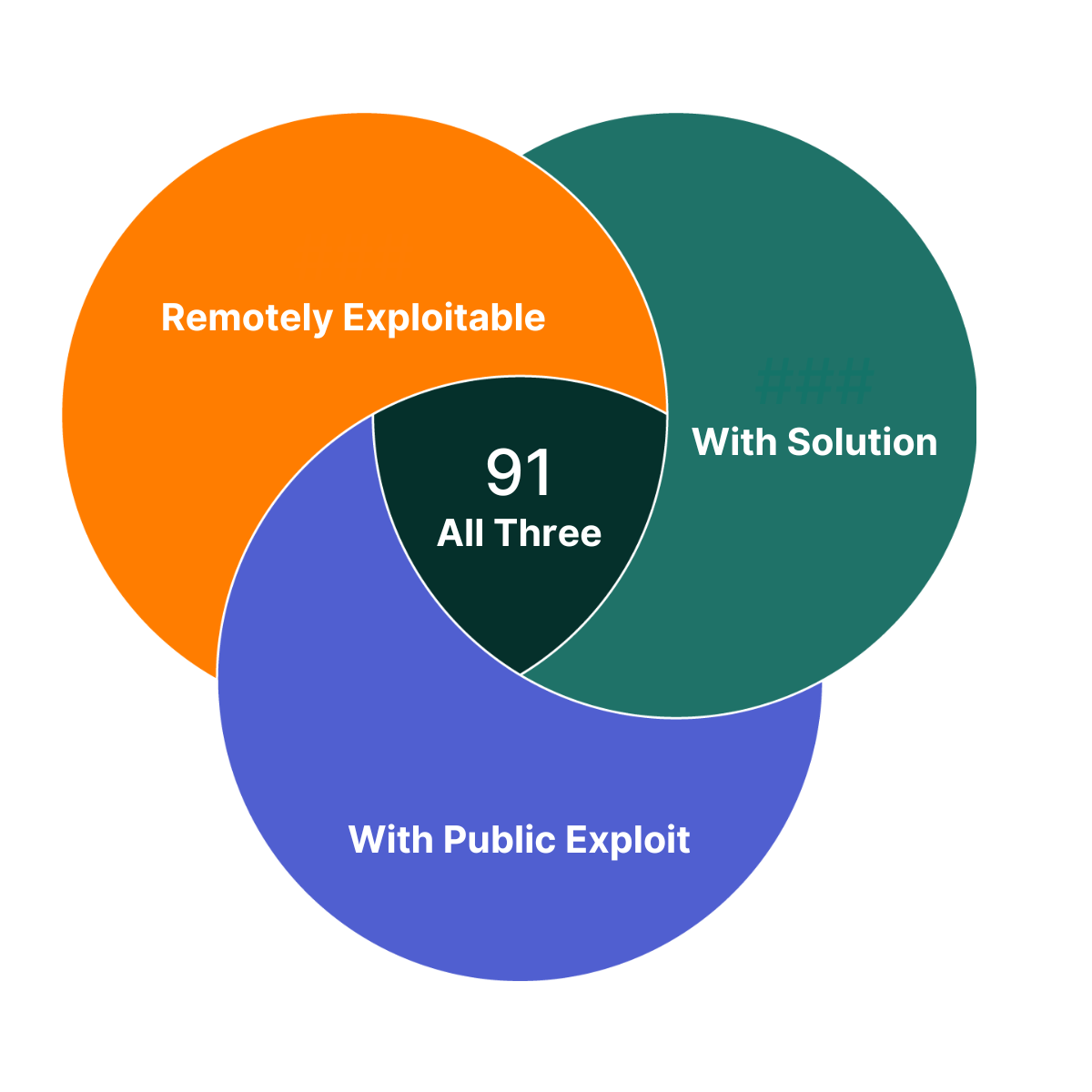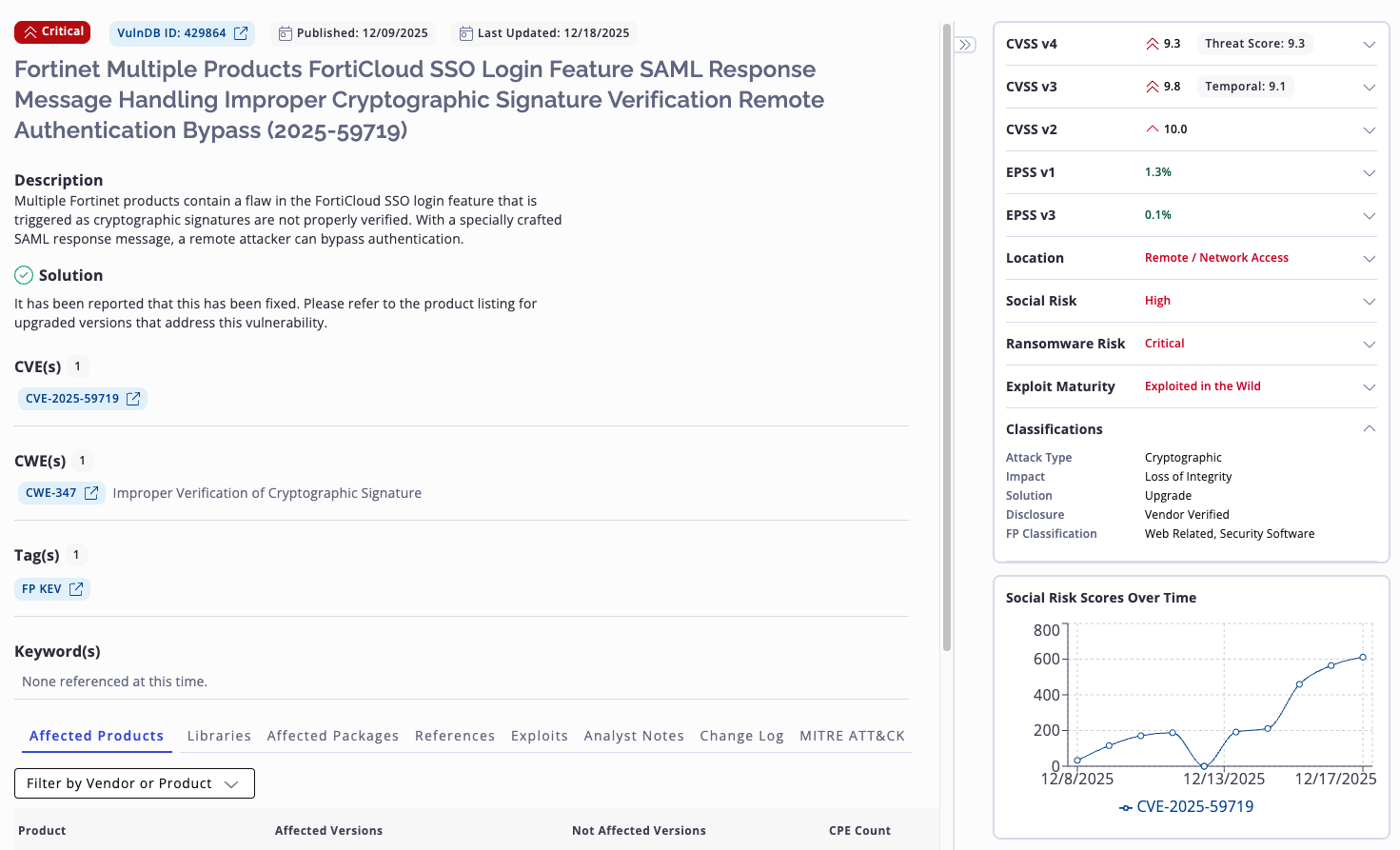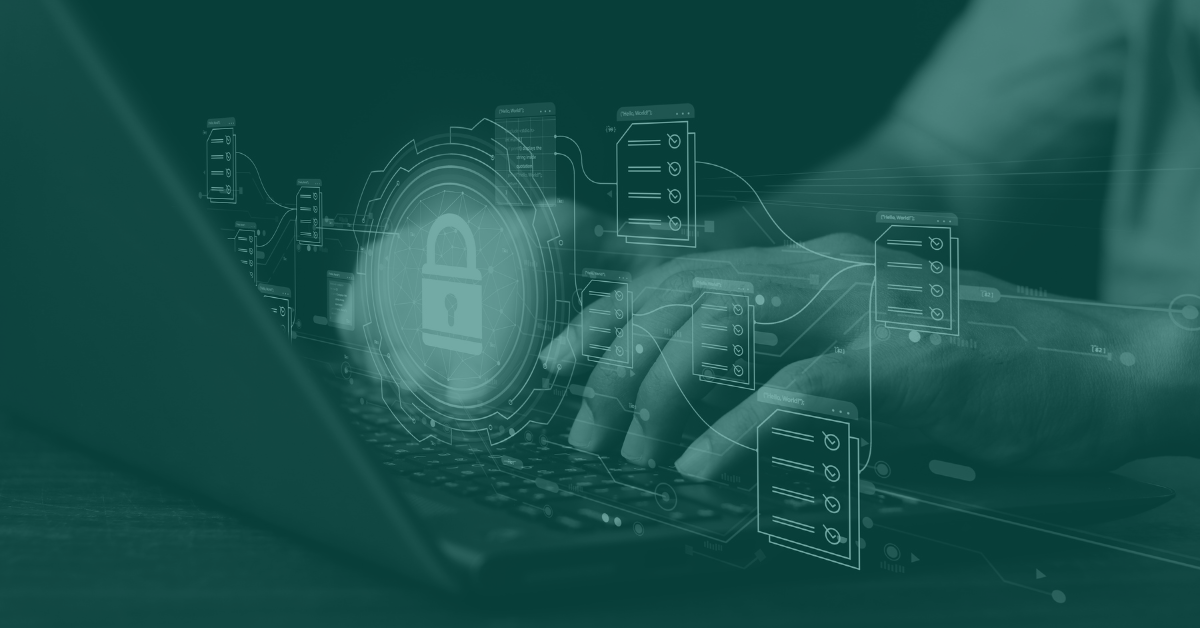Flashpoint’s VulnDB documents over 400,000 vulnerabilities and has over 6,000 entries in Flashpoint’s KEV database, making it a critical resource as vulnerability exploitation rises. However, if your organization is relying solely on CVE data, you may be missing critical vulnerability metadata and insights that hinder timely remediation. That’s why we created this weekly series—where we surface and analyze the most high priority vulnerabilities security teams need to know about.
Key Vulnerabilities:
Week of December 6 – December 12, 2025
Foundational Prioritization
Of the vulnerabilities Flashpoint published this week, there are 91 that you can take immediate action on. They each have a solution, a public exploit exists, and are remotely exploitable. As such, these vulnerabilities are a great place to begin your prioritization efforts.

Diving Deeper – Urgent Vulnerabilities
Of the vulnerabilities Flashpoint published last week, seven are highlighted in this week’s Vulnerability Insights and Prioritization Report because they contain one or more of the following criteria:
- Are in widely used products and are potentially enterprise-affecting
- Are exploited in the wild or have exploits available
- Allow full system compromise
- Can be exploited via the network alone or in combination with other vulnerabilities
- Have a solution to take action on
In addition, all of these vulnerabilities are easily discoverable and therefore should be investigated and fixed immediately.
To proactively address these vulnerabilities and ensure comprehensive coverage beyond publicly available sources on an ongoing basis, organizations can leverage Flashpoint Vulnerability Intelligence. Flashpoint provides comprehensive coverage encompassing IT, OT, IoT, CoTs, and open-source libraries and dependencies. It catalogs over 100,000 vulnerabilities that are not included in the NVD or lack a CVE ID, ensuring thorough coverage beyond publicly available sources. The vulnerabilities that are not covered by the NVD do not yet have CVE ID assigned and will be noted with a VulnDB ID.
| CVE ID | Title | CVSS Scores (v2, v3, v4) | Exploit Status | Exploit Consequence | Ransomware Likelihood Score | Social Risk Score | Solution Availability |
| CVE-2025-14174 | ANGLE libANGLE/renderer/metal/TextureMtl.mm TextureMtl::setPerSliceSubImage() Function Insufficient Memory Allocation Heap Buffer Overflow | 9.3 9.8 9.3 | Exploited in the Wild | Arbitrary Code Execution | High | High | Manual patch to source code |
| CVE-2025-43529 | Apple WebKit Unspecified Web Content Handling Use-after-free Arbitrary Code Execution | 6.8 8.8 8.6 | Exploited in the Wild | Arbitrary Code Execution | Critical | N/A | Yes |
| CVE-2025-8110 | Gogs PutContents API Symbolic Link Handling File Overwrite Remote Command Execution | 9.0 8.8 8.7 | Exploited in the Wild | Command Execution | Medium | High | No |
| CVE-2025-59719 | Fortinet Multiple Products FortiCloud SSO Login Feature SAML Response Message Handling Improper Cryptographic Signature Verification Remote Authentication Bypass (2025-59719) | 10.0 9.8 9.3 | Exploit Private | Authentication Bypass | Critical | High | Yes |
| CVE-2025-59718 | Fortinet Multiple Products FortiCloud SSO Login Feature SAML Response Message Handling Improper Cryptographic Signature Verification Remote Authentication Bypass (2025-59718) | 10.0 9.8 9.3 | Private | Authentication Bypass | Critical | High | Yes |
| CVE-2025-14087 | GNOME GLib gvariant-parser.c Multiple Functions Large String Parsing Integer Overflow Out-of-bounds Write Arbitrary Code Execution | 9.3 9.8 9.3 | POC Public | Arbitrary Code Execution | High | Low | Yes |
| CVE-2025-62221 | Microsoft Windows Cloud Files Mini Filter Driver Unspecified Use-after-free Local Privilege Escalation | 7.2 7.8 8.5 | Exploited in the Wild | Privilege Escalation | Low | High | Yes |
NOTES: The severity of a given vulnerability score can change whenever new information becomes available. Flashpoint maintains its vulnerability database with the most recent and relevant information available. Login to view more vulnerability metadata and for the most up-to-date information.
CVSS scores: Our analysts calculate, and if needed, adjust NVD’s original CVSS scores based on new information being available.
Social Risk Score: Flashpoint estimates how much attention a vulnerability receives on social media. Increased mentions and discussions elevate the Social Risk Score, indicating a higher likelihood of exploitation. The score considers factors like post volume and authors, and decreases as the vulnerability’s relevance diminishes.
Ransomware Likelihood: This score is a rating that estimates the similarity between a vulnerability and those known to be used in ransomware attacks. As we learn more information about a vulnerability (e.g. exploitation method, technology affected) and uncover additional vulnerabilities used in ransomware attacks, this rating can change.
Flashpoint Ignite lays all of these components out. Below is an example of what this vulnerability record for CVE-2025-59719 looks like.

This record provides additional metadata like affected product versions, MITRE ATT&CK mapping, analyst notes, solution description, classifications, vulnerability timeline and exposure metrics, exploit references and more.
Analyst Comments on the Notable Vulnerabilities
Below, Flashpoint analysts describe the five vulnerabilities highlighted above as vulnerabilities that should be of focus for remediation if your organization is exposed.
CVE-2025-14174
ANGLE contains an overflow condition in the TextureMtl::setPerSliceSubImage() function in libANGLE/renderer/metal/TextureMtl.mm that is triggered as an incorrect value is used to allocate a buffer. This may allow a context-dependent attacker to cause a heap-based buffer overflow, potentially allowing the execution of arbitrary code. Google rates the severity as “High” for Google Chrome on Mac. This rating is normally for issues with potential code execution impact within the sandbox. It also covers issues that interfere with browser security features or circumvent the same-origin policy.
As of December 10, this has been reported as being exploited in the wild. Apple released security advisories that confirm that this vulnerability was “exploited in an extremely sophisticated attack against specific targeted individuals on versions of iOS before iOS 26.”
CVE-2025-43529
Apple WebKit contains an unspecified use-after-free error that is triggered as certain input is not properly validated. With specially crafted web content, a context-dependent attacker can dereference already freed memory and potentially execute arbitrary code.
As of December 12, this has been reported as being exploited in the wild.
CVE-2025-8110
Gogs contains a flaw in the PutContents application programming interface (API) that is triggered as symbolic links in Git repositories are not properly handled. This may allow an authenticated, remote attacker to overwrite files outside of the Git repository and subsequently execute arbitrary commands. This vulnerability may only be exploited by an attacker with repository creation permissions, which is enabled by default. Although exploitation requires authentication, arbitrary attackers can exploit the vulnerability if open-registration is enabled (default setting).
As of July 10, this has been reported as being exploited in the wild. This issue can be exploited by creating a repository containing a symbolic link pointing to the .git/config file. By using the PutContents API, the attacker can modify the file and add a “sshCommand” entry that allows the execution of arbitrary shell commands.
CVE-2025-59719 and CVE-2025-59718
Multiple Fortinet products contain a flaw in the FortiCloud SSO login feature that is triggered as cryptographic signatures are not properly verified. With a specially crafted SAML response message, a remote attacker can bypass authentication.
CVE-2025-14087
GNOME GLib contains an integer overflow condition in the bytestring_parse() and string_parse() functions in gvariant-parser.c that is triggered as an improper integer type is used as a loop index for parsing large strings. This may allow a context-dependent attacker to cause an out-of-bounds write, crashing a process linked against the library and potentially allowing the execution of arbitrary code.
CVE-2025-62221
Microsoft Windows contains an unspecified use-after-free error in the Cloud Files Mini Filter driver that is triggered as certain input is not properly validated. This may allow a local attacker to dereference already freed memory and gain SYSTEM privileges.
As of December 9, this has been reported as being exploited in the wild.
Previously Highlighted Vulnerabilities
| CVE/VulnDB ID | Flashpoint Published Date |
| CVE-2025-21218 | Week of January 15, 2025 |
| CVE-2024-57811 | Week of January 15, 2025 |
| CVE-2024-55591 | Week of January 15, 2025 |
| CVE-2025-23006 | Week of January 22, 2025 |
| CVE-2025-20156 | Week of January 22, 2025 |
| CVE-2024-50664 | Week of January 22, 2025 |
| CVE-2025-24085 | Week of January 29, 2025 |
| CVE-2024-40890 | Week of January 29, 2025 |
| CVE-2024-40891 | Week of January 29, 2025 |
| VulnDB ID: 389414 | Week of January 29, 2025 |
| CVE-2025-25181 | Week of February 5, 2025 |
| CVE-2024-40890 | Week of February 5, 2025 |
| CVE-2024-40891 | Week of February 5, 2025 |
| CVE-2024-8266 | Week of February 12, 2025 |
| CVE-2025-0108 | Week of February 12, 2025 |
| CVE-2025-24472 | Week of February 12, 2025 |
| CVE-2025-21355 | Week of February 24, 2025 |
| CVE-2025-26613 | Week of February 24, 2025 |
| CVE-2024-13789 | Week of February 24, 2025 |
| CVE-2025-1539 | Week of February 24, 2025 |
| CVE-2025-27364 | Week of March 3, 2025 |
| CVE-2025-27140 | Week of March 3, 2025 |
| CVE-2025-27135 | Week of March 3, 2025 |
| CVE-2024-8420 | Week of March 3, 2025 |
| CVE-2024-56196 | Week of March 10, 2025 |
| CVE-2025-27554 | Week of March 10, 2025 |
| CVE-2025-22224 | Week of March 10, 2025 |
| CVE-2025-1393 | Week of March 10, 2025 |
| CVE-2025-24201 | Week of March 17, 2025 |
| CVE-2025-27363 | Week of March 17, 2025 |
| CVE-2025-2000 | Week of March 17, 2025 |
| CVE-2025-27636 CVE-2025-29891 | Week of March 17, 2025 |
| CVE-2025-1496 | Week of March 24, 2025 |
| CVE-2025-27781 | Week of March 24, 2025 |
| CVE-2025-29913 | Week of March 24, 2025 |
| CVE-2025-2746 | Week of March 24, 2025 |
| CVE-2025-29927 | Week of March 24, 2025 |
| CVE-2025-1974 CVE-2025-2787 | Week of March 31, 2025 |
| CVE-2025-30259 | Week of March 31, 2025 |
| CVE-2025-2783 | Week of March 31, 2025 |
| CVE-2025-30216 | Week of March 31, 2025 |
| CVE-2025-22457 | Week of April 2, 2025 |
| CVE-2025-2071 | Week of April 2, 2025 |
| CVE-2025-30356 | Week of April 2, 2025 |
| CVE-2025-3015 | Week of April 2, 2025 |
| CVE-2025-31129 | Week of April 2, 2025 |
| CVE-2025-3248 | Week of April 7, 2025 |
| CVE-2025-27797 | Week of April 7, 2025 |
| CVE-2025-27690 | Week of April 7, 2025 |
| CVE-2025-32375 | Week of April 7, 2025 |
| VulnDB ID: 398725 | Week of April 7, 2025 |
| CVE-2025-32433 | Week of April 12, 2025 |
| CVE-2025-1980 | Week of April 12, 2025 |
| CVE-2025-32068 | Week of April 12, 2025 |
| CVE-2025-31201 | Week of April 12, 2025 |
| CVE-2025-3495 | Week of April 12, 2025 |
| CVE-2025-31324 | Week of April 17, 2025 |
| CVE-2025-42599 | Week of April 17, 2025 |
| CVE-2025-32445 | Week of April 17, 2025 |
| VulnDB ID: 400516 | Week of April 17, 2025 |
| CVE-2025-22372 | Week of April 17, 2025 |
| CVE-2025-32432 | Week of April 29, 2025 |
| CVE-2025-24522 | Week of April 29, 2025 |
| CVE-2025-46348 | Week of April 29, 2025 |
| CVE-2025-43858 | Week of April 29, 2025 |
| CVE-2025-32444 | Week of April 29, 2025 |
| CVE-2025-20188 | Week of May 3, 2025 |
| CVE-2025-29972 | Week of May 3, 2025 |
| CVE-2025-32819 | Week of May 3, 2025 |
| CVE-2025-27007 | Week of May 3, 2025 |
| VulnDB ID: 402907 | Week of May 3, 2025 |
| VulnDB ID: 405228 | Week of May 17, 2025 |
| CVE-2025-47277 | Week of May 17, 2025 |
| CVE-2025-34027 | Week of May 17, 2025 |
| CVE-2025-47646 | Week of May 17, 2025 |
| VulnDB ID: 405269 | Week of May 17, 2025 |
| VulnDB ID: 406046 | Week of May 19, 2025 |
| CVE-2025-48926 | Week of May 19, 2025 |
| CVE-2025-47282 | Week of May 19, 2025 |
| CVE-2025-48054 | Week of May 19, 2025 |
| CVE-2025-41651 | Week of May 19, 2025 |
| CVE-2025-20289 | Week of June 3, 2025 |
| CVE-2025-5597 | Week of June 3, 2025 |
| CVE-2025-20674 | Week of June 3, 2025 |
| CVE-2025-5622 | Week of June 3, 2025 |
| CVE-2025-5419 | Week of June 3, 2025 |
| CVE-2025-33053 | Week of June 7, 2025 |
| CVE-2025-5353 | Week of June 7, 2025 |
| CVE-2025-22455 | Week of June 7, 2025 |
| CVE-2025-43200 | Week of June 7, 2025 |
| CVE-2025-27819 | Week of June 7, 2025 |
| CVE-2025-49132 | Week of June 13, 2025 |
| CVE-2025-49136 | Week of June 13, 2025 |
| CVE-2025-50201 | Week of June 13, 2025 |
| CVE-2025-49125 | Week of June 13, 2025 |
| CVE-2025-24288 | Week of June 13, 2025 |
| CVE-2025-6543 | Week of June 21, 2025 |
| CVE-2025-3699 | Week of June 21, 2025 |
| CVE-2025-34046 | Week of June 21, 2025 |
| CVE-2025-34036 | Week of June 21, 2025 |
| CVE-2025-34044 | Week of June 21, 2025 |
| CVE-2025-7503 | Week of July 12, 2025 |
| CVE-2025-6558 | Week of July 12, 2025 |
| VulnDB ID: 411705 | Week of July 12, 2025 |
| VulnDB ID: 411704 | Week of July 12, 2025 |
| CVE-2025-6222 | Week of July 12, 2025 |
| CVE-2025-54309 | Week of July 18, 2025 |
| CVE-2025-53771 | Week of July 18, 2025 |
| CVE-2025-53770 | Week of July 18, 2025 |
| CVE-2025-54122 | Week of July 18, 2025 |
| CVE-2025-52166 | Week of July 18, 2025 |
| CVE-2025-53942 | Week of July 25, 2025 |
| CVE-2025-46811 | Week of July 25, 2025 |
| CVE-2025-52452 | Week of July 25, 2025 |
| CVE-2025-41680 | Week of July 25, 2025 |
| CVE-2025-34143 | Week of July 25, 2025 |
| CVE-2025-50454 | Week of August 1, 2025 |
| CVE-2025-8875 | Week of August 1, 2025 |
| CVE-2025-8876 | Week of August 1, 2025 |
| CVE-2025-55150 | Week of August 1, 2025 |
| CVE-2025-25256 | Week of August 1, 2025 |
| CVE-2025-43300 | Week of August 16, 2025 |
| CVE-2025-34153 | Week of August 16, 2025 |
| CVE-2025-48148 | Week of August 16, 2025 |
| VulnDB ID: 416058 | Week of August 16, 2025 |
| CVE-2025-32992 | Week of August 16, 2025 |
| CVE-2025-7775 | Week of August 24, 2025 |
| CVE-2025-8424 | Week of August 24, 2025 |
| CVE-2025-34159 | Week of August 24, 2025 |
| CVE-2025-57819 | Week of August 24, 2025 |
| CVE-2025-7426 | Week of August 24, 2025 |
| CVE-2025-58367 | Week of September 1, 2025 |
| CVE-2025-58159 | Week of September 1, 2025 |
| CVE-2025-58048 | Week of September 1, 2025 |
| CVE-2025-39247 | Week of September 1, 2025 |
| CVE-2025-8857 | Week of September 1, 2025 |
| CVE-2025-58321 | Week of September 8, 2025 |
| CVE-2025-58366 | Week of September 8, 2025 |
| CVE-2025-58371 | Week of September 8, 2025 |
| CVE-2025-55728 | Week of September 8, 2025 |
| CVE-2025-55190 | Week of September 8, 2025 |
| VulnDB ID: 419253 | Week of September 13, 2025 |
| CVE-2025-10035 | Week of September 13, 2025 |
| CVE-2025-59346 | Week of September 13, 2025 |
| CVE-2025-55727 | Week of September 13, 2025 |
| CVE-2025-10159 | Week of September 13, 2025 |
| CVE-2025-20363 | Week of September 20, 2025 |
| CVE-2025-20333 | Week of September 20, 2025 |
| CVE-2022-4980 | Week of September 20, 2025 |
| VulnDB ID: 420451 | Week of September 20, 2025 |
| CVE-2025-9900 | Week of September 20, 2025 |
| CVE-2025-52906 | Week of September 27, 2025 |
| CVE-2025-51495 | Week of September 27, 2025 |
| CVE-2025-27224 | Week of September 27, 2025 |
| CVE-2025-27223 | Week of September 27, 2025 |
| CVE-2025-54875 | Week of September 27, 2025 |
| CVE-2025-41244 | Week of September 27, 2025 |
| CVE-2025-61928 | Week of October 6, 2025 |
| CVE-2025-61882 | Week of October 6, 2025 |
| CVE-2025-49844 | Week of October 6 2025 |
| CVE-2025-57870 | Week of October 6, 2025 |
| CVE-2025-34224 | Week of October 6, 2025 |
| CVE-2025-34222 | Week of October 6, 2025 |
| CVE-2025-40765 | Week of October 11, 2025 |
| CVE-2025-59230 | Week of October 11, 2025 |
| CVE-2025-24990 | Week of October 11, 2025 |
| CVE-2025-61884 | Week of October 11, 2025 |
| CVE-2025-41430 | Week of October 11, 2025 |
| VulnDB ID: 424051 | Week of October 18, 2025 |
| CVE-2025-62645 | Week of October 18, 2025 |
| CVE-2025-61932 | Week of October 18, 2025 |
| CVE-2025-59503 | Week of October 18, 2025 |
| CVE-2025-43995 | Week of October 18, 2025 |
| CVE-2025-62168 | Week of October 18, 2025 |
| VulnDB ID: 425182 | Week of October 25, 2025 |
| CVE-2025-62713 | Week of October 25, 2025 |
| CVE-2025-54964 | Week of October 25, 2025 |
| CVE-2024-58274 | Week of October 25, 2025 |
| CVE-2025-41723 | Week of October 25, 2025 |
| CVE-2025-20354 | Week of November 1, 2025 |
| CVE-2025-11953 | Week of November 1, 2025 |
| CVE-2025-60854 | Week of November 1, 2025 |
| CVE-2025-64095 | Week of November 1, 2025 |
| CVE-2025-11833 | Week of November 1, 2025 |
| CVE-2025-64446 | Week of November 8, 2025 |
| CVE-2025-36250 | Week of November 8, 2025 |
| CVE-2025-64400 | Week of November 8, 2025 |
| CVE-2025-12686 | Week of November 8, 2025 |
| CVE-2025-59118 | Week of November 8, 2025 |
| VulnDB ID: 426231 | Week of November 8, 2025 |
| VulnDB ID: 427979 | Week of November 22, 2025 |
| CVE-2025-55796 | Week of November 22, 2025 |
| CVE-2025-64428 | Week of November 22, 2025 |
| CVE-2025-62703 | Week of November 22, 2025 |
| VulnDB ID: 428193 | Week of November 22, 2025 |
| CVE-2025-65018 | Week of November 22, 2025 |
| CVE-2025-54347 | Week of November 22, 2025 |
| CVE-2025-55182 | Week of November 29, 2025 |
| CVE-2024-14007 | Week of November 29, 2025 |
| CVE-2025-66399 | Week of November 29, 2025 |
| CVE-2022-35420 | Week of November 29, 2025 |
| CVE-2025-66516 | Week of November 29, 2025 |
| CVE-2025-59366 | Week of November 29, 2025 |
Transform Vulnerability Management with Flashpoint
Request a demo today to see how Flashpoint can transform your vulnerability intelligence, vulnerability management, and exposure identification program.



